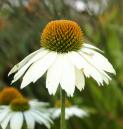Natural Order, Ericaceae; sub-order, Ericineae; tribe, Rhodoreae.
By GUSTAV FRANK KUEHNEL, PH.G.
From an Inaugural Essay.
This plant is indigenous to the United States from Maine to Ohio, but chiefly in the mountainous parts of Pennsylvania, and southward along shaded water courses in damp, deep woods; it is a shrub or tree, 6 to 20 feet high, with handsome flowers, the corolla being bell-shaped, an inch broad, of a pale rose color, or nearly white, greenish in the throat on the upper side, and yellow or reddish spotted. The leaves are from 4 to 10 inches long, evergreen, coriaceous, alternate, elliptical oblong, or lance oblong, acute, narrowed towards the base, very smooth, unequal at the base, and with an entire, somewhat revolute, margin, near which the anastomosing veins form one or two distinct wavy lines. A quantity of the leaves were collected for me about the middle of August by Mr. Henry C. C. Maisch, a fellow-student and classmate, in the neighborhood of Cresson Springs, Pa. These were carefully dried, remote from heat and direct rays of the sun, powdered, and subjected to an examination which resulted in isolating the three constituents, according to Prof. Maisch, apparently characteristic for coriaceous leaves of ericaceous plants, viz., arbutin, ericolin and ursone; besides these principles, tannin, gallic acid, resin, wax, albumen, coloring matter and a trace of volatile oil were observed.
A portion of the powdered drug was subjected successively to the treatment of petroleum spirit, ether and alcohol, according to Dragendorff.
The solution in petroleum spirit was evaporated at the ordinary temperature; towards the close of the operation a pungent, peculiar odor, slightly irritating, was perceptible, possibly due to a little volatile oil; a soft, semi-solid, waxy mass, of a peculiar resinous odor, was left as a residue.
The etherial liquid was allowed to spontaneously evaporate at the ordinary temperature, and the resulting residue was treated with water and filtered. The filtrate was found to contain gallic acid, by treating with acetic ether, separating and evaporating, when crystals were left which in solution darkened upon addition of solution of iron salt, but on being heated the color vanished; the liquid gave no precipitate with solution of gelatin.
The residue on the filter after treating the etherial extract with water was composed chiefly of resin, associated with chlorophyll and other coloring matter.
The alcoholic tincture obtained by macerating the powdered leaves which had been previously exhausted by petroleum spirit and ether was evaporated to an extract, which was then treated with water and filtered.
The residue left on the filter was well washed and dissolved in hot alcohol, which on cooling deposited an apparently amorphous mass, ursone; upon redissolving in alcohol, microscopic needles were obtained, which upon addition of sulphuric acid turned black, reddening the acid, and became yellow with nitric acid, giving off nitrous acid fumes.
The aqueous filtrate was concentrated, treated with acetate of lead, filtered, the filtrate freed from lead by sulphuretted hydrogen, concentrated to a syrupy consistence, again diluted somewhat, and treated with animal charcoal, then concentrated and set aside, when a deposit of acicular crystals was obtained, which proved to be arbutin. An alkaline solution of the crystals gave the sky-blue color with phospho-molybdic acid. Sulphuric acid dissolved them without change of color, but nitric acid turned yellow, with the evolution of nitrous acid fumes.
The precipitate obtained with lead acetate was suspended in water, the lead removed by sulphuretted hydrogen, the filtrate heated to expel excess of sulphuretted hydrogen, and treated with solution of gelatin, when a bulky precipitate was obtained, which, after washing with water, became black on the addition of an iron salt, thus showing it to be tannin.
A second portion of the leaves was treated with water, and the infusion boiled and strained, leaving a flocculent residue of albumen on the strainer. The clear liquid was then concentrated and treated with solution of acetate of lead, the precipitate separated by a filter, and the filtrate freed from lead by sulphuretted hydrogen; the filtrate was heated to expel excess of sulphuretted hydrogen, treated with animal charcoal to remove coloring matter, Concentrated, and set aside, when crystals of arbutin were deposited, showing the reactions mentioned above.
The lead precipitates contained tannin and gallic acid, and some arbutin was extracted from the sulphide of lead, and obtained in crystals. The mother-liquors of arbutin seem to contain ericolin.
The American Journal of Pharmacy, Vol. 57, 1885, was edited by John M. Maisch.

